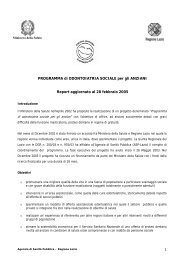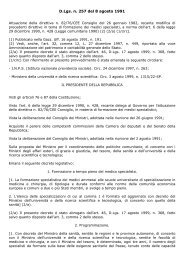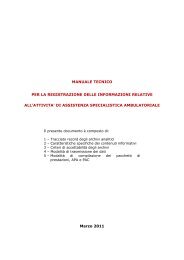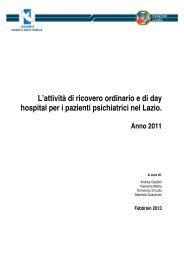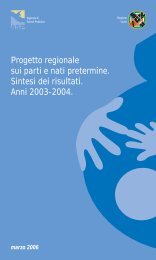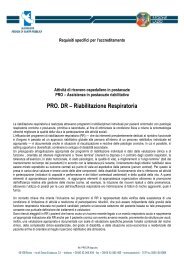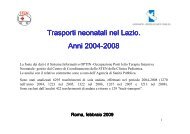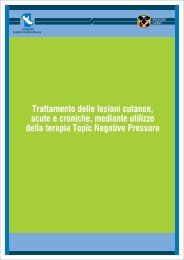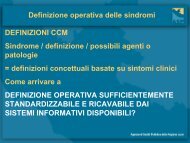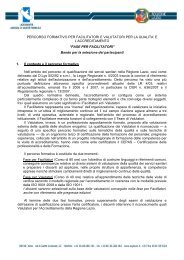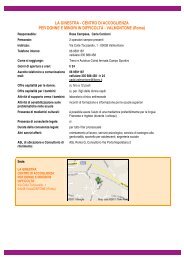_______________________________LAZIOSANITÁ – <strong>Agenzia</strong> <strong>di</strong> Sanità <strong>Pubblica</strong>________________________________L’emergenza: capacità <strong>di</strong> ricovero da pronto soccorsoStefano Genio, Stefania Trifelli, ASP <strong>Lazio</strong>SanitàIntroduzioneL’in<strong>di</strong>catore permette <strong>di</strong> valutare se una struttura ospedaliera è in grado <strong>di</strong> far fronte in modocompletamente autosufficiente alla richiesta <strong>di</strong> ricovero dal proprio pronto soccorso (PS). Questo in<strong>di</strong>catore,letto con il successivo ‘Non risponde a chiamata’, fornisce in<strong>di</strong>cazioni utili per valutare il trattamento delpaziente che presentando almeno un livello <strong>di</strong> urgenza <strong>di</strong>fferibile, può avere la necessità <strong>di</strong> unproseguimento dell’assistenza a livello ospedaliero.La decisione <strong>di</strong> ricoverare il paziente che si è recato in Pronto Soccorso implica tutta una serie <strong>di</strong>adempimenti organizzativi per il pronto soccorso legati alla necessità <strong>di</strong> trovare il posto letto opportuno per ilpaziente, tanto che con la Dgr del 3 novembre 2009, n. 821 (Interventi per il miglioramento <strong>della</strong> efficaciaed efficienza nelle attività <strong>di</strong> Pronto Soccorso dei Presi<strong>di</strong> Ospedalieri <strong>della</strong> <strong>Regione</strong> <strong>Lazio</strong>. “Facilitatore deiprocessi <strong>di</strong> ricovero e <strong>di</strong>missione”) è stata creata una figura che ha il compito <strong>di</strong> supportare il prontosoccorso nel processo <strong>di</strong> ricovero.La mancanza, al momento <strong>della</strong> richiesta <strong>di</strong> ricovero, <strong>di</strong> una <strong>di</strong>sponibilità <strong>di</strong> posti letto nella specialità <strong>di</strong>reparto a cui il paziente deve essere destinato può rendere necessario il trasferimento dello stesso versoun’altra struttura ospedaliera. Al <strong>di</strong> là <strong>di</strong> quei trasferimenti incomprimibili in quanto legati alla continuità <strong>di</strong>soccorso, la necessità <strong>di</strong> organizzare il trasferimento del paziente per ricerca <strong>di</strong> posto letto può costituire un<strong>di</strong>sagio organizzativo non solo per il pronto soccorso, ma anche per l’assistito ed i suoi familiari inconsiderazione del probabile aumento <strong>di</strong> <strong>di</strong>stanza tra la residenza dell’assistito e la struttura <strong>di</strong> ricovero. Talenecessità <strong>di</strong> trasferimento si verifica in modo più frequente nei perio<strong>di</strong> <strong>di</strong> forte incremento delle richieste <strong>di</strong>ricovero da pronto soccorso ed in particolare in corrispondenza dell’epidemia stagionale <strong>di</strong> sindromiinfluenzali tipiche del periodo invernale quando si verifica storicamente un consistente volume <strong>di</strong>trasferimenti per in<strong>di</strong>sponibilità <strong>di</strong> posto letto dai PS/DEA generali <strong>di</strong> Roma verso i reparti <strong>di</strong> altri ospedaliaccre<strong>di</strong>tati pubblici o privati.Al fine <strong>di</strong> stimare il fabbisogno <strong>di</strong> posti letto per l’emergenza per PS/DEA aggiuntivi rispetto all’attualedotazione complessiva dell’ospedale, già nel DPCA 73/2010 ‘Rete assistenziale dell’emergenza’, era statamisurata, con criteri analoghi a quelli utilizzati nel presente in<strong>di</strong>catore, la capacità <strong>di</strong> ricovero da prontosoccorso.Meto<strong>di</strong>I dati sono desunti dal Sistema Informativo Ospedaliero negli ultimi 5 anni. Sono state selezionate le<strong>di</strong>missioni <strong>di</strong> pazienti provenienti da PS <strong>della</strong> struttura <strong>di</strong> riferimento o da PS <strong>di</strong> altre strutture. L’in<strong>di</strong>catore ècalcolato come rapporto tra i giorni <strong>di</strong> degenza dei pazienti ricoverati nella struttura sede <strong>di</strong> pronto soccorsoed il totale dei giorni <strong>di</strong> degenza in seguito a ricovero o trasferimento [B/B+C]Per ciascun PS sono stata quin<strong>di</strong> calcolate:B: totale <strong>di</strong> giornate <strong>di</strong> degenza erogate a pazienti provenienti dal proprio PSC: totale delle giornate <strong>di</strong> degenza erogate nelle strutture ospedaliere <strong>di</strong> destinazione, non dotate <strong>di</strong> PS/DEA,a pazienti trasferiti dai PS/DEA.RisultatiIl dato regionale me<strong>di</strong>o negli ultimi anni si attesta intorno al 96%. In generale <strong>di</strong>fficoltà nell'assorbire iricoveri da pronto soccorso si evidenziano principalmente negli ospedali <strong>di</strong> Roma e <strong>della</strong> sua provincia,mentre le strutture ospedaliere delle altre provincie mostrano una quasi totale capacità <strong>di</strong> assorbimento deiricoveri da pronto soccorso. I trend per gli ospedali Casilino e Pertini rilevano che oltre il 20% <strong>di</strong> pazienti nonriesce a trovare ricovero nella struttura. Le strutture specialistiche (Eastman, Oftalmico e Bambino Gesù)riescono invece ad assorbire la richiesta <strong>di</strong> ricovero dei pazienti. La struttura "Coniugi Bernar<strong>di</strong>ni" nei primianni <strong>di</strong> analisi non ha registrato nei dati <strong>di</strong> <strong>di</strong>missione ricoveri da PS (ma solo guar<strong>di</strong>a me<strong>di</strong>ca e specialista).DiscussioneIn me<strong>di</strong>a la quota dei trasferimenti da PS verso altri ospedali è molto limitata. Ci sono tuttavia strutturesituate in zone notoriamente sottoposte a notevole pressione da parte dei pazienti che presentano unacapacità <strong>di</strong> ricovero da PS non adeguata alla richiesta. Per alcuni PS che presentavano una capacità <strong>di</strong>ricovero da pronto soccorso nettamente inferiore alla me<strong>di</strong>a regionale e che non presentavano alcunmargine <strong>di</strong> recupero, ovvero che presentavano già un livello alto <strong>di</strong> <strong>di</strong>sponibilità al ricovero da prontosoccorso, e quin<strong>di</strong> non avevano ulteriori giornate <strong>di</strong> degenza da destinare al pronto soccorso, secondoquanto evidenziato nell’allegato 9.1 del DPCA 73/2010, è stata prevista nel DPCA 80/2010 una dotazione385
_______________________________LAZIOSANITÁ – <strong>Agenzia</strong> <strong>di</strong> Sanità <strong>Pubblica</strong>________________________________aggiuntiva <strong>di</strong> posti letto per acuti da utilizzare per i ricoveri provenienti dall’emergenza. Poiché tale dotazioneaggiuntiva è stata implementata nel corso del 2011, sulla base dei dati 2010 non è ancora possibilemisurarne l’impatto sulla capacità <strong>di</strong> ricovero da pronto soccorso, ed occorrerà pertanto attendere le analisisui dati 2011 per verificare se si riscontra un aumento <strong>della</strong> capacità <strong>di</strong> ricovero da PS nelle strutture cheevidenziano valori nettamente inferiori alla me<strong>di</strong>a regionale.Riferimenti bibliograficiDPCA 73/2010. Rete assistenziale dell’emergenza.DELIBERAZIONE DELLA GIUNTA REGIONALE del 3 novembre 2009, n. 821. Interventi per il miglioramento <strong>della</strong> efficaciaed efficienza nelle attività <strong>di</strong> Pronto Soccorso dei Presi<strong>di</strong> Ospedalieri <strong>della</strong> <strong>Regione</strong> <strong>Lazio</strong>. In<strong>di</strong>viduazione delle funzioni del“Facilitatore dei processi <strong>di</strong> ricovero e <strong>di</strong>missione”.HRRC Hospital Report Research Collaborative. Hospital Report EMERGENCY DEPARTMENT CARE 2007. Ontario HospitalAssociation Government of Ontario;Department of Health. 2002, “NHS Performance In<strong>di</strong>cators”, British J Healthc Comp and Inf Man; 19(5):18-20 [ab]Bagust A, Place M, Posnett JW. Dynamics of bed use in accommodating emergency admissions: stochastic simulationmodel. BMJ 1999; 319: 155 – 8.Bazzoli GJ, Brewster LR, Liu G, Kuo S. Does U.S. hospital capacity need to be expanded?. Health Aff.November/December 2003; 22 (6): 40 – 54.Cooke MW, Wilson S, Halsall J, Roalfe A. Total time in English accident and emergency departments is related to bedoccupancy. Emerg Med J 2004; 21: 575 – 6.Derlet RW, Richards JR. Overcrow<strong>di</strong>ng in the nation’s emergency departments: complex causes and <strong>di</strong>sturbing effects.Ann Emerg Med. January 2000; 35: 63 – 8.G. Lori, S. Genio, F. Biagetti, F. Serio, A. De Luca, G. Guasticchi. “A set of performance in<strong>di</strong>cators to evaluate thehospitals response to the Emergency Department overcrow<strong>di</strong>ng during the winter time in Rome (Italy)”. Posterpresentato al congresso “The fourth me<strong>di</strong>terranean emergency me<strong>di</strong>cine congress (MEMC IV)”, Sorrento 15 – 19settembre 2007.S. J. Weiss, R. Derlet, J. Arndahl, A. A. Ernst, J. Richards, M. Fernandez-Frankelton, R. Schwab, T. O. Stair, P. Vicellio, D.Levy, M. Brautigan, A. Johnson, T. G. Nick. Estimating the Degree of Emergency Department Overcrow<strong>di</strong>ng in AcademicMe<strong>di</strong>cal Centers: Results of the National ED Overcrow<strong>di</strong>ng Study (NEDOCS). Acad Emerg Med. 2004; 11:38–50.S. J. Weiss, A. A. Ernst, T. G. Nick. Comparison of the National Emergency Department Overcrow<strong>di</strong>ng Scale and theEmergency Department Work Index for Quantifying Emergency Department Crow<strong>di</strong>ng. Acad Emerg Med. 2006; 13:513–518.386
- Page 3 and 4:
Responsabile del progetto: Aldo Ros
- Page 5 and 6:
_______________________________LAZI
- Page 7 and 8:
_______________________________LAZI
- Page 10:
6 ( ) ( )
- Page 24:
297.220
- Page 29:
1,8
- Page 33 and 34:
0,5 30
- Page 35:
2,1 19.558
- Page 44:
277.356 41
- Page 52:
770.593
- Page 62:
2,5
- Page 68:
377.587
- Page 72:
490.602
- Page 75 and 76:
11.070
- Page 78:
7.044 75
- Page 82:
0,7 2.544 79
- Page 86:
1,4 17.198
- Page 91:
619.206
- Page 95 and 96:
1,6
- Page 98 and 99:
1,3
- Page 101 and 102:
0,3
- Page 103 and 104:
81.298
- Page 105 and 106:
210.074
- Page 107 and 108:
104
- Page 109 and 110:
186.732
- Page 111 and 112:
108
- Page 113 and 114:
0,3 110
- Page 116 and 117:
1,9
- Page 118 and 119:
376.113
- Page 120 and 121:
117
- Page 122 and 123:
79.074
- Page 124 and 125:
1,5
- Page 126 and 127:
425.799
- Page 128 and 129:
2,0
- Page 130 and 131:
127
- Page 132 and 133:
284.819 129
- Page 134 and 135:
0,2
- Page 136 and 137:
0,7 13
- Page 138 and 139:
58.298
- Page 140 and 141:
2,0 43.949
- Page 142 and 143:
1,7
- Page 144 and 145:
4.744 141
- Page 146 and 147:
1,6
- Page 148 and 149:
145
- Page 150:
147
- Page 153 and 154:
150
- Page 155 and 156:
152
- Page 157 and 158:
297.141
- Page 159 and 160:
0,9 21.554 156
- Page 161:
158
- Page 164 and 165:
161
- Page 166 and 167:
163
- Page 168 and 169:
289.577
- Page 170 and 171:
1,5
- Page 172 and 173:
169
- Page 174 and 175:
262.866
- Page 176 and 177:
2,2
- Page 178 and 179:
441.004
- Page 180 and 181:
12.249 177
- Page 182 and 183:
170.157 179
- Page 185 and 186:
182
- Page 187 and 188:
184
- Page 189 and 190:
943.968 186
- Page 191 and 192:
2,0
- Page 193 and 194:
717.195
- Page 195 and 196:
2,6
- Page 197 and 198:
1.219.419
- Page 199 and 200:
1,7
- Page 201 and 202:
198
- Page 203 and 204:
512.316 200
- Page 205 and 206:
202
- Page 207 and 208:
46.279
- Page 209 and 210:
206
- Page 211 and 212:
368.820
- Page 213 and 214:
113.689
- Page 215 and 216:
202.793
- Page 217 and 218:
131.935 214
- Page 219 and 220:
1,5
- Page 221 and 222:
218
- Page 223 and 224:
1,5
- Page 225 and 226:
0,4 222
- Page 228 and 229:
1,4 225
- Page 230 and 231:
227
- Page 232 and 233:
366.108
- Page 234 and 235:
231
- Page 236 and 237:
233
- Page 238 and 239:
241.082
- Page 240 and 241:
210.623
- Page 242 and 243:
1.459 239
- Page 244 and 245:
241
- Page 246 and 247:
243
- Page 248:
245
- Page 251 and 252:
248
- Page 253 and 254:
1.230.129 250
- Page 255 and 256:
252
- Page 258 and 259:
2,7
- Page 260 and 261:
446.552
- Page 262 and 263:
259
- Page 264 and 265:
261
- Page 266 and 267:
263
- Page 268 and 269:
2,5
- Page 270 and 271:
1.257.335 267
- Page 272 and 273:
269
- Page 274 and 275:
59.804
- Page 276 and 277:
93.278 273
- Page 278 and 279:
144.646 275
- Page 280 and 281:
277
- Page 282 and 283:
88.000
- Page 284:
17.822 281
- Page 287 and 288:
284
- Page 289 and 290:
286
- Page 291 and 292:
462.342
- Page 293 and 294:
2,5
- Page 295 and 296:
292
- Page 297 and 298:
294
- Page 299 and 300:
129.742
- Page 301 and 302:
298
- Page 303 and 304:
300
- Page 305 and 306:
3,2
- Page 307 and 308:
304
- Page 309 and 310:
306
- Page 311 and 312:
308
- Page 313 and 314:
310
- Page 315 and 316:
312
- Page 317 and 318:
314
- Page 319 and 320:
316
- Page 321 and 322:
1,0 61.700
- Page 323 and 324:
320
- Page 326 and 327:
2,5
- Page 328 and 329:
325
- Page 330 and 331:
327
- Page 332 and 333:
2,7
- Page 334 and 335:
922.394
- Page 336 and 337:
333
- Page 338 and 339: 335
- Page 340 and 341: 1.289.644
- Page 342 and 343: 339
- Page 344 and 345: 341
- Page 346 and 347: 343
- Page 348 and 349: 9,1
- Page 350 and 351: 347
- Page 352 and 353: 349
- Page 354 and 355: 351
- Page 356 and 357: 2.131.545
- Page 358 and 359: 355
- Page 360 and 361: 1.208.911
- Page 362 and 363: 240.235
- Page 364 and 365: 11,7 1.
- Page 366 and 367: 0,3
- Page 368 and 369: 11,8
- Page 370 and 371: 367
- Page 372 and 373: 13,1 846.930
- Page 374 and 375: 3,2
- Page 376 and 377: 1.071.694
- Page 378 and 379: 375
- Page 380 and 381: 377
- Page 382 and 383: 379
- Page 384 and 385: _______________________________LAZI
- Page 386 and 387: _______________________________LAZI
- Page 390 and 391: _______________________________LAZI
- Page 392 and 393: _______________________________LAZI
- Page 394 and 395: _______________________________LAZI
- Page 396 and 397: _______________________________LAZI
- Page 398 and 399: _______________________________LAZI
- Page 400 and 401: _______________________________LAZI
- Page 402 and 403: _______________________________LAZI
- Page 404 and 405: _______________________________LAZI
- Page 406 and 407: APPENDICEL’attività delle Case d
- Page 408 and 409: _______________________________LAZI
- Page 410 and 411: Ricoveri ripetuti nell'anno in CdC
- Page 412 and 413: ________________________________Fon
- Page 414 and 415: ________________________________Fon
- Page 416 and 417: ________________________________Fon
- Page 418: _______________________________LAZI




